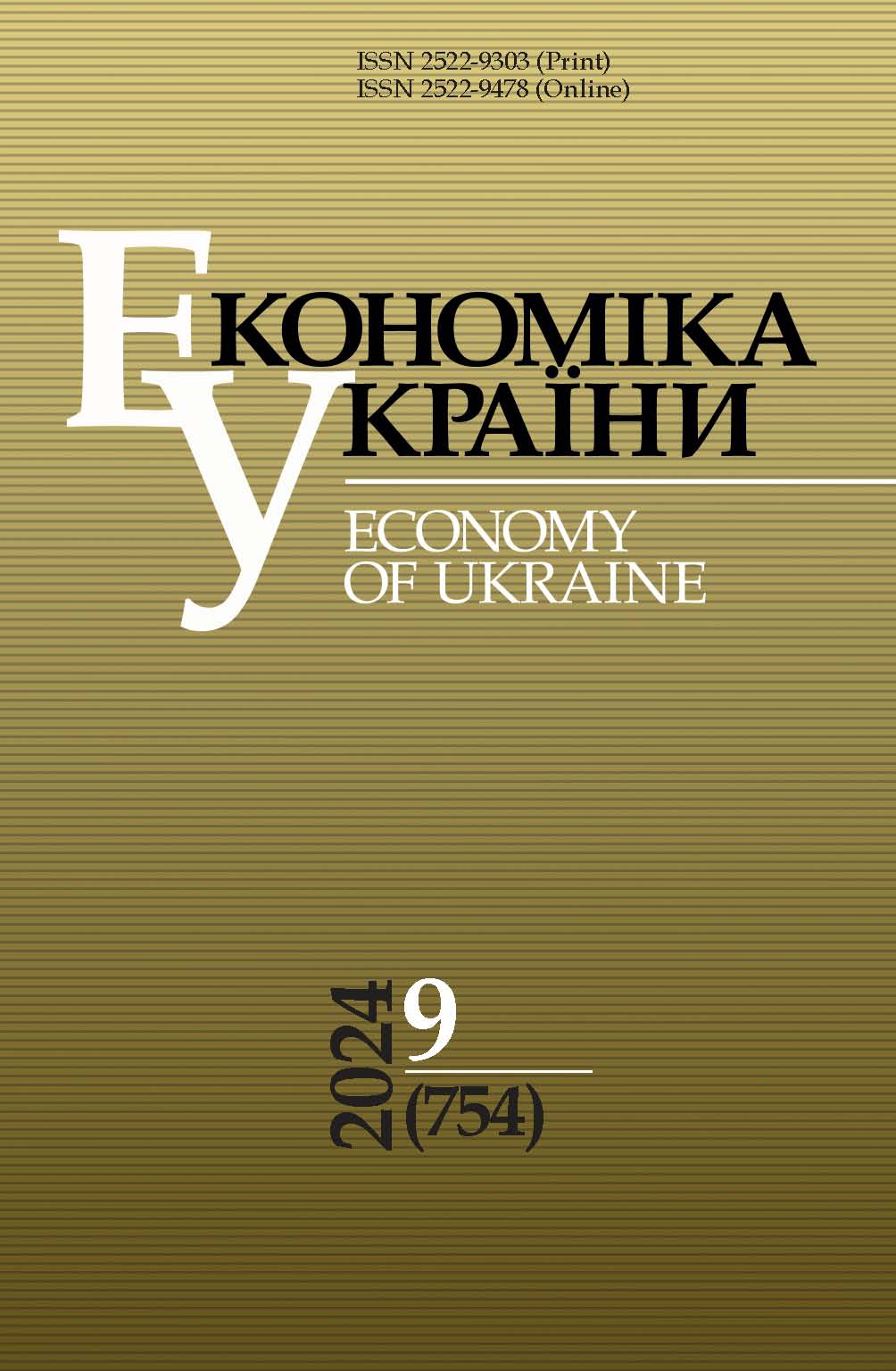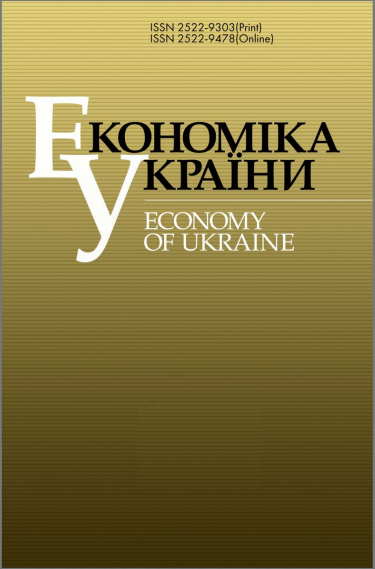REGULATORY POLICY OF THE NATIONAL BANK OF UKRAINE: PROBLEMS AND WAYS TO IMPROVE
DOI:
https://doi.org/10.15407/economyukr.2024.09.003Keywords:
methodological approach; National Bank of Ukraine; bank management; banking system of Ukraine; monetary policy; stability of prices and the banking system; economic development; credit monitoring mechanismAbstract
The article notes that the National Bank of Ukraine (NBU) must ensure price stability, high and stable level of economic development and optimal employment. Conceptually agreeing with this approach, the authors prove that the mechanism for its implementation does not ensure the fulfillment of the NBU mission.
Analyzing changes in the banking sector of Ukraine over the last 2.5 years, the authors emphasize that due to the implementation of insufficiently balanced NBU regulatory policy, the volume of banks' investments in NBU certificates of deposit increased almost fivefold –– from UAH 95 billion. at the beginning of 2022 to UAH 456 billion at the end of the year.
As a result of such an unsuccessful policy and contrary to economic logic, the NBU generated a huge positive liquidity balance in the banking sector, while the real sector of the economy suffers from a lack of funds
Undoubtedly, such regulatory actions, which are "unique" in modern economic theory and historical practice, cannot stand criticism and should be rethought and significantly revised.
The reasons and consequences of such an ineffective regulatory policy of the NBU are analyzed and important conceptual ideas aimed at improving bank management are suggested.
According to the formulated conclusions, it is necessary to create an effective mechanism of credit monitoring in Ukraine. The activity of which should be devoted to assessing economically justified levels of different banking rates and analyzing innovations in the ideology of banking management that are used in other countries where central banks operate very successfully.
References
Smaghi, L., Casini, C. (2000). Monetary and fiscal policy co-operation: Institutions and procedures in EMU. Journal of Common Market Studies, 38(3). 375-391. https://doi.org/10.1111/1468-5965.00226
Silva, C., Vieira, F. (2017). Monetary and fiscal policy in advanced and developing countries: An analysis before and after the financial crisis. The Quarterly Review of Economics and Finance. Vol. 63. Р. 13-20. https://doi.org/10.1016/j.qref.2016.04.013
Aiyagari, S., Gertler, M. (1985). The backing of government bonds and monetarism. Journal of Monetary Economics. Vol. 16. Iss. 1. Р. 19-44. https://doi.org/10.1016/0304-3932(85)90004-2
Leeper, E., Davig, T. (2011). Monetary-fiscal policy interactions and fiscal stimulus. European Economic Review. Vol. 55. Iss. 2. P. 211-227. https://doi.org/10.1016/j.euroecorev.2010.04.004
Ghatak, S., Moore, T. (2011). Monetary policy rules for transition economies: An empirical analysis. Review of Development Economics. Vol. 15. Iss. 4. Р. 714-728. https://doi.org/10.1111/j.1467-9361.2011.00638.x
Galí, J., Perotti, R. (2003). Fiscal policy and monetary integration in Europe. Economic Policy. Vol. 18. Iss. 37. Р. 533-572. https://doi.org/10.3386/w9773
Brzozowski, M., Siwiska-Gorzelak, J. (2010). The impact of fiscal rules on fiscal policy volatility. Journal of Applied Economics. Vol. 13. Р. 205-231. https://doi.org/10.1016/S1514-0326(10)60010-4
Altavilla, C. (2003). Assessing monetary rules performance across EMU countries. International Journal of Finance and Economics. Vol. 8. Iss. 2. Р. 131-151. https://doi.org/10.1002/ijfe.199
Reinhart, C., Rogoff, K. (2008). This time is different: Eight centuries of financial folly. Princeton, NJ, Princeton University Press. https://doi.org/10.1515/9781400831722
Clausen, V., Hayo, B. (2002). Monetary policy in the Euro area –– Lessons from the first years. No. 103. Royal Economic Society Annual Conference 2003. https://doi.org/10.2139/ssrn.313779
Andrade, J., Pires, M. (2011). Implications of public debt indexation for monetary policy transmission. Journal of Applied Economics. Vol. XIV. No. 2. Р. 257-268. https://doi.org/10.1016/S1514-0326(11)60014-7
Beetsma, R., Jensen, H. (2005). Monetary and fiscal policy interactions in a micro-founded model of a monetary union. Journal of International Economics. Vol. 67. Iss. 2. Р. 320-352. https://doi.org/10.1016/j.jinteco.2005.03.001
Leith, C., von Thadden, L. (2008). Monetary and fiscal policy interactions in a new Keynesian model with capital accumulation and non-Ricardian consumers. Working paper series of Economic Theory. No. 140(1). Р. 1-40. https://doi.org/10.1016/j.jet.2007.07.005
Lagoa, S. (2016). Determinants of inflation differentials in the Euro area: Is the new Keynesian Phillips curve enough? Journal of Applied Economics. No. 20(1). Р. 75-103. https://doi.org/10.1016/S1514-0326(17)30004-1
Mantsurov, I. (2015). Post-War successful rehabilitation of Ukraine in the framework of Constitutional and Institutional Changes. Modeling and Information Systems in Economics: Collection of Scientific Papers. No. 91. Р. 36-44. URL: https://www.academia.edu/70962615/Post_War_successful_rehabilitation_of_Ukraine_in_the_framework_of_Constitutional_and_institutional_changes
Mantsurov, I. (2011). Institutional planning in the system of state regulation of the economy. Kyiv. 655 p. [in Ukrainian].
Bianchi, F., Ilut, C. (2017). Monetary/fiscal policy mix and agent’s beliefs. Review of Economic Dynamics. Vol. 26. Р. 113-139. https://doi.org/10.1016/j.red.2017.02.011
Afonso, A., Toffano, P. (2013). Fiscal regimes in the EU. European Central Bank. Working Paper series. No. 1529. https://doi.org/10.2139/ssrn.2239160
Haga, M. (2015). On central bank independence and political cycles. Journal of Applied Economics. Vol. 18. Р. 267-296. https://doi.org/10.1016/S1514-0326(15)30012-X
Downloads
Published
How to Cite
Issue
Section
License
Copyright (c) 2024 Publisher PH "Academperiodyka" of the NAS of Ukraine

This work is licensed under a Creative Commons Attribution-NonCommercial-NoDerivatives 4.0 International License.



